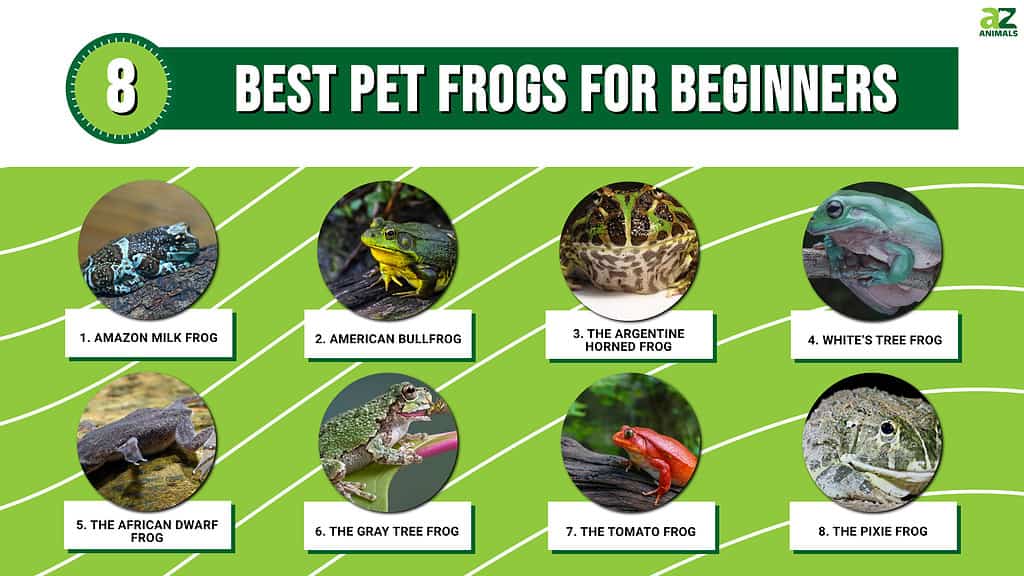
The American bullfrog and the leopard frog were once the only options for frog keepers, but now there is a far wider variety of frogs to choose from. With the success of captive breeding programs, there is now plenty to pick from. In case you’ve always wanted an amphibian as a pet, consider one of these eight frogs. Use the following guide to understand the best pet frogs for beginners. It’s important to check the regulations in your area, as bullfrogs and other amphibians may be illegal to own in some places.
1. Amazon Milk Frog
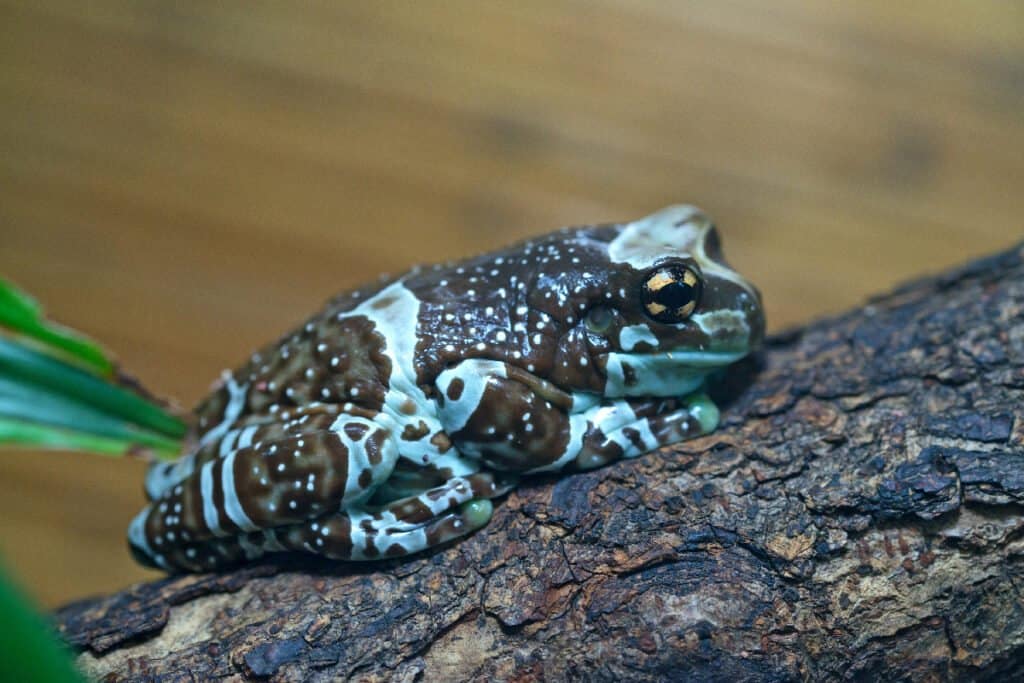
Amazon Milk Frog
©iStock.com/Oskanov
The Amazon milk frog (Trachycephalus resinifictrix) is one of the best pet frogs for beginners. It is a well-liked species of frog among herp keepers. The Amazon milk frog is an arboreal species that typically hunt from perches in the tree tops near wooded areas. It is commonly raised in captivity and naturally reproduces in tree holes. Males’ sizes start at 2.5 inches and go up to four inches, while women’s sizes start at two inches. Their huge size, large hands, and large toe pads all help them in their tree-dwelling lifestyle.
2. American Bullfrog
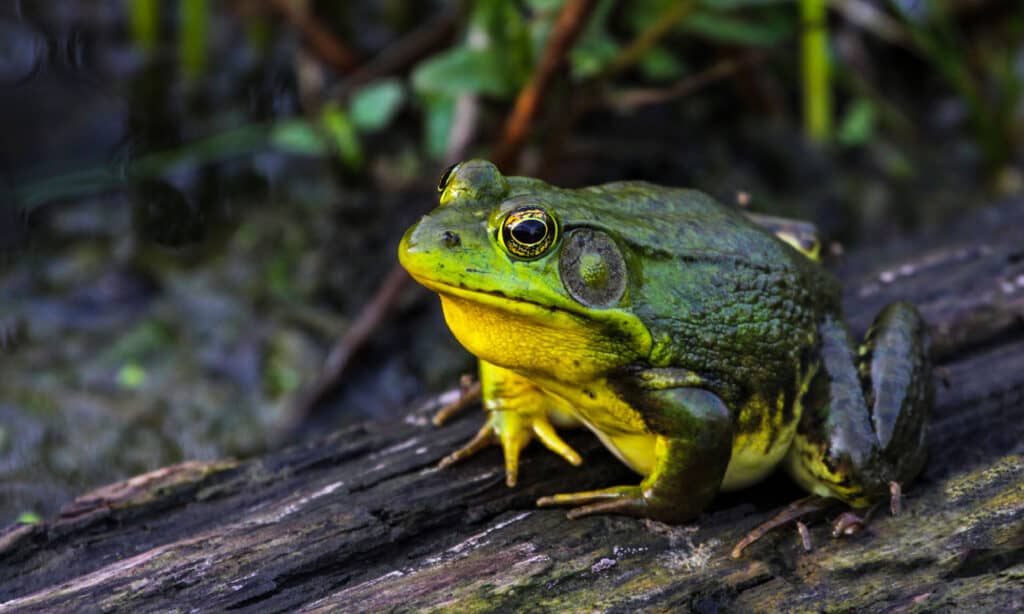
American Bullfrog
©iStock.com/187715314
One of the largest native frogs in the Americas is the American bullfrog (Rana catesbeiana). The American bullfrog is a huge, powerful, and brutish frog that can reach a maximum length of about eight inches. With their large, webbed feet, these frogs are excellent swimmers, and their ravenous appetites mean they can devour virtually any food item that fits in their mouths. The frog is an invasive species in many areas, and it can be found naturally in 36 U.S. states. The American bullfrog has been successfully bred in captivity, and its tadpoles may be obtained at most aquariums, pet stores, and reptile expos.
3. The Argentine Horned Frog

Horned Frog
The Argentine (or ornate, or Bell’s) horned frog (Ceratophrys ornata) is one of the best pet frogs for beginners. It is affectionately known as the Pac-Man frog due in part to the size of its mouth and the way in which it stuffs prey items into it. The frog is commonly kept in captivity, reproduced, and comes in a broad variety of morphs, making it a favorite among herp keepers. These amphibians reach a maximum size of around six inches, and they are not particularly energetic creatures, rather instead to wait patiently for prey to come to them.
4. White’s Tree Frog

White’s tree frog
©Hwe Ie/Shutterstock.com
Northern and Eastern Australia and New Guinea are home to the White’s tree frog, commonly known as the Australian green tree frog or the dumpy frog (Litoria caerulea). There is a plethora of these frogs available at reptile exhibits, pet stores, and even online because they are so frequently kept and bred in captivity.
5. The African Dwarf Frog
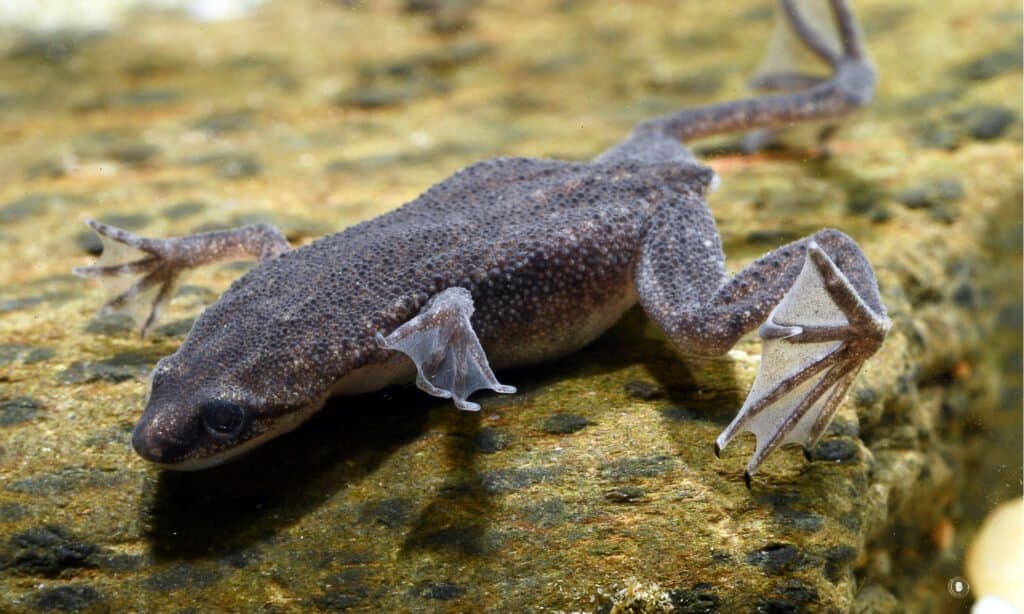
African Dwarf Frog
©Guillermo Guerao Serra/Shutterstock.com
It is true that the African Dwarf Frog lives in water. The fact that it spends its entire existence below the surface sets it apart from the other examples. Yet, it lacks gills and must come to the water’s surface to breathe. If you have a frog in a planted aquarium, make sure the frog can get to the surface for air by keeping the aquarium from being overgrown with plants.
If you have experience maintaining an aquarium, this frog species is a good choice. They live in an environment not dissimilar to that of fish found in freshwater or the tropics. It’s true that African Dwarf Frogs may coexist with other community fish if your aquarium is large enough. These toads are about three inches in length and can survive for five to ten years. They have a range of colors from olive to brown and come in four distinct forms. They are one of the best pet frogs for beginners.
6. The Gray Tree Frog
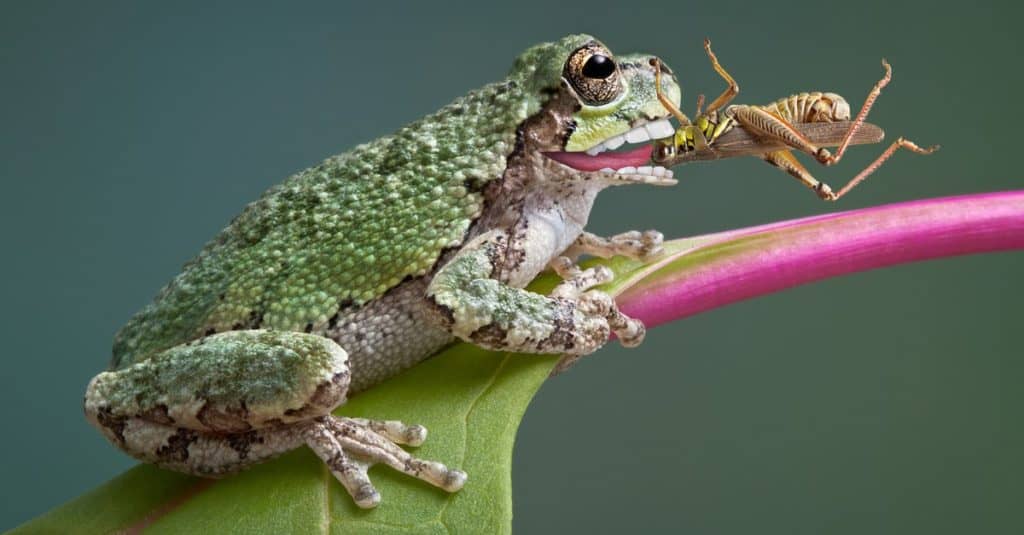
Gray Tree Frog
©Cathy Keifer/Shutterstock.com
The Gray tree frog requires little attention. This frog can survive a lot and is common. This frog spends most of its time in the wild perched high in the canopy of trees due to its affinity for climbing. They enjoy climbing; therefore, a tall aquarium gives them the opportunity to do so.
The coloration of the gray tree frog varies depending on its environment, although it is typically brown, green, or light gray. The warty exterior of the gray tree frog is intriguing, but the golden yellow-orange color on the interior sections of the hind thighs is far more so. In addition, they stand out from other frogs thanks to the white patch that sits directly beneath each of their eyes.
7. The Tomato Frog
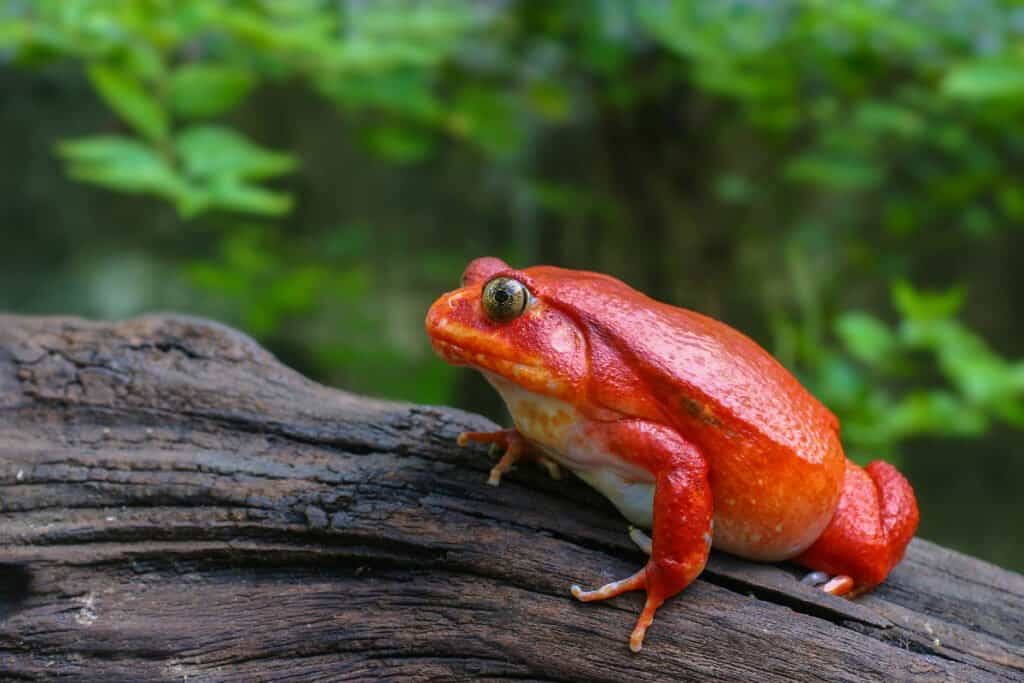
Tomato frogs’ funny little faces have made them increasingly popular pets
©Krisda Ponchaipulltawee/Shutterstock.com
The name “tomato frog” makes sense until you actually see one. Its plump, red body suggests a fruity moniker, and it gets one. An adult female stands out from the males with her more vibrant orange-red coloring, while juvenile frogs are often yellow. It’s possible that you won’t see the color you want until your frog is fully grown; also, a female frog will likely have the most varied coloring of the two sexes.
Tomato Frogs, like Pacman Frogs, are semi-fossorial, meaning they prefer to remain partially buried while keeping an eye on their surroundings. Their lips are disproportionately small for the rest of their body, which they can swell to protect themselves. Their typical lifespan is six years. This frog is one of the best pet frogs for beginners.
8. The Pixie Frog
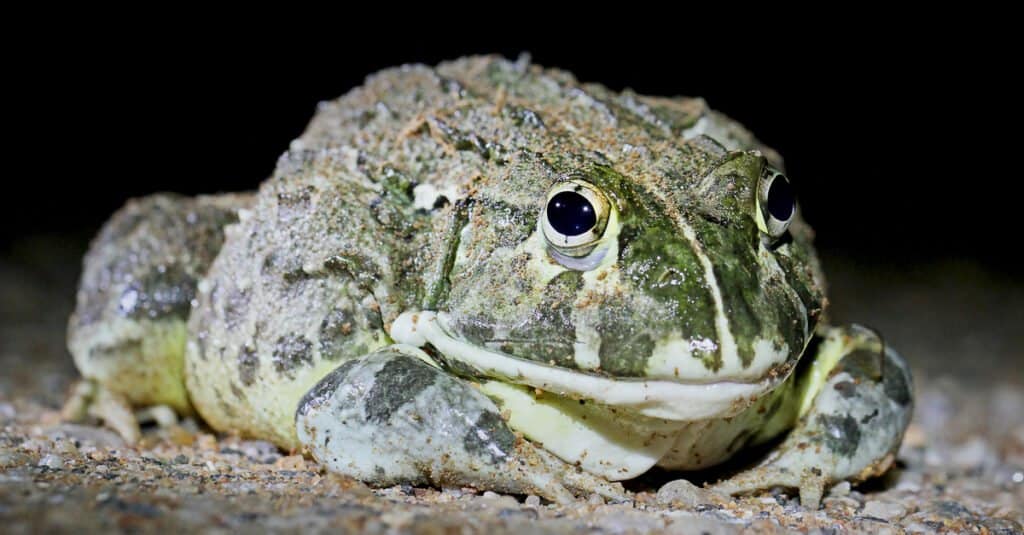
Pixie frog aka
edible frog
or African giant bullfrog
©Eugene Troskie/Shutterstock.com
One of the more unusual of these frogs is the Pixie frog, sometimes known as the edible frog or African giant bullfrog. Males of this species can grow to be six to ten inches long, making it the second-largest frog species. The females are more petite than the males. In order to prevent cannibalism, each frog needs its own 40-gallon aquarium. Pixie frogs have large fangs and can cause serious injury if they bite.
Some pixie frogs are friendly and welcome human interaction, whereas others are easily frightened and become protective when approached. Even tame animals have the potential to bite if they misinterpret your fingers as food. So far as care goes, this frog is rather tolerant. They have a voracious appetite and rarely skip meals. Crickets, earthworms, silkworms, wax worms, dubia roaches, and even small mice are all fair game for them.
Summary of The 8 Best Pet Frogs For Beginners
| Frog | Size | Fun Facts | |
|---|---|---|---|
| 1 | Amazon Milk Frog | Up to 4 inches | They produce a sticky, milk-like substance when threatened |
| 2 | American Bullfrog | Up to 8 inches | Considered to be an invasive species in some areas – tadpoles can be purchased in some pet stores |
| 3 | Argentine Horned Frog | Up to 6 inches | Known for being lazy – these frogs wait on prey to come to them |
| 4 | White’s Tree Frog | Around 4 inches | It is also known as the dumpy tree frog because of fat deposits around its head |
| 5 | African Dwarf Frog | Around 3 inches | Spends most of its time under the water |
| 6 | Gray Tree Frog | Up to 2 inches | They enjoy climbing and need a tall aquarium |
| 7 | Tomato Frog | Up to 4 inches | You won’t know what color your frog will be until it is full-grown |
| 8 | Pixie Frog | Up to 10 inches | They have fangs that can cause a painful bite – must be kept in an aquarium by itself to prevent cannibalism |
The photo featured at the top of this post is © Steve Byland/Shutterstock.com
Thank you for reading! Have some feedback for us? Contact the AZ Animals editorial team.







